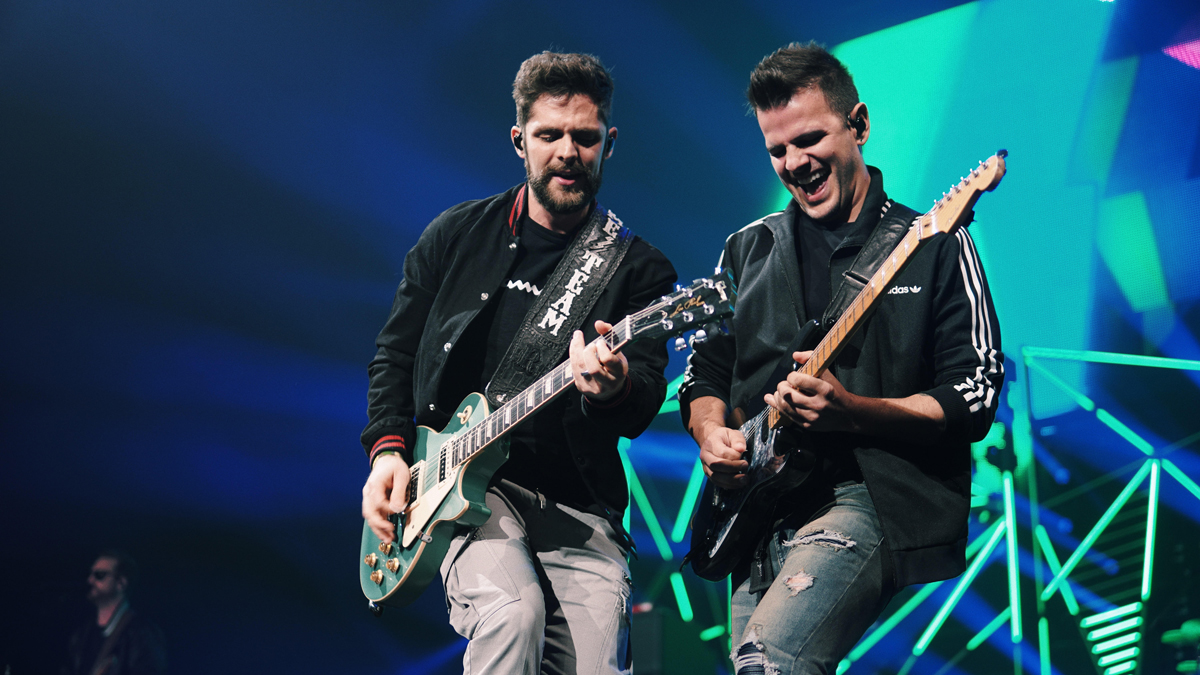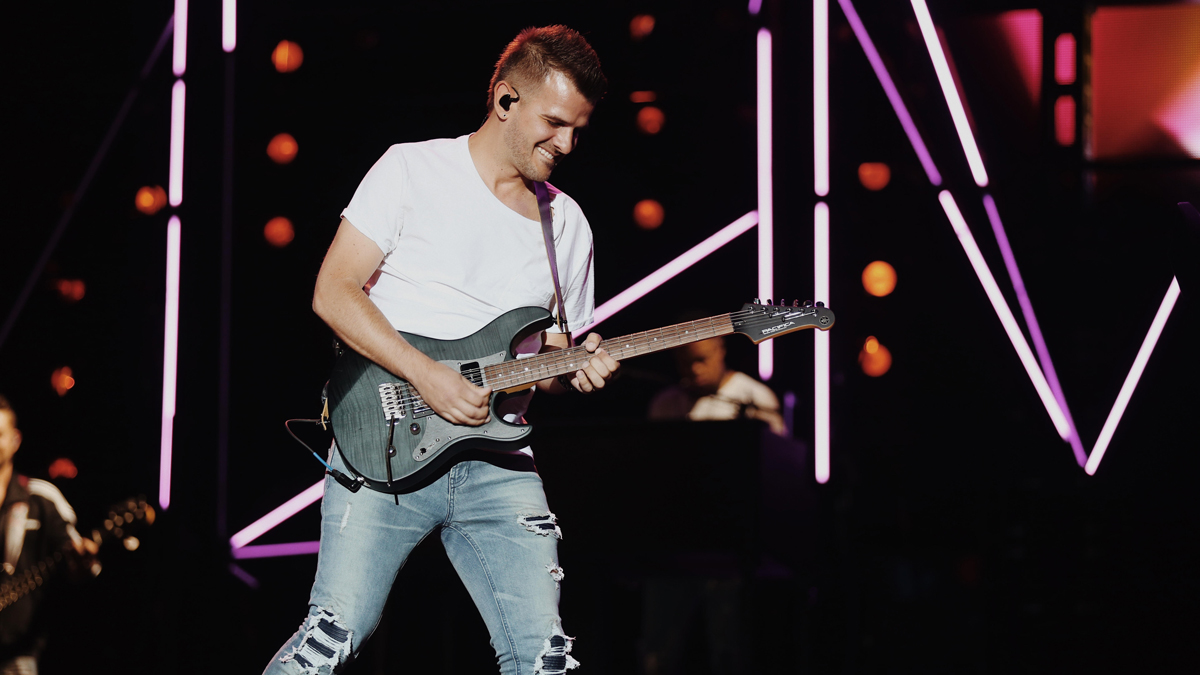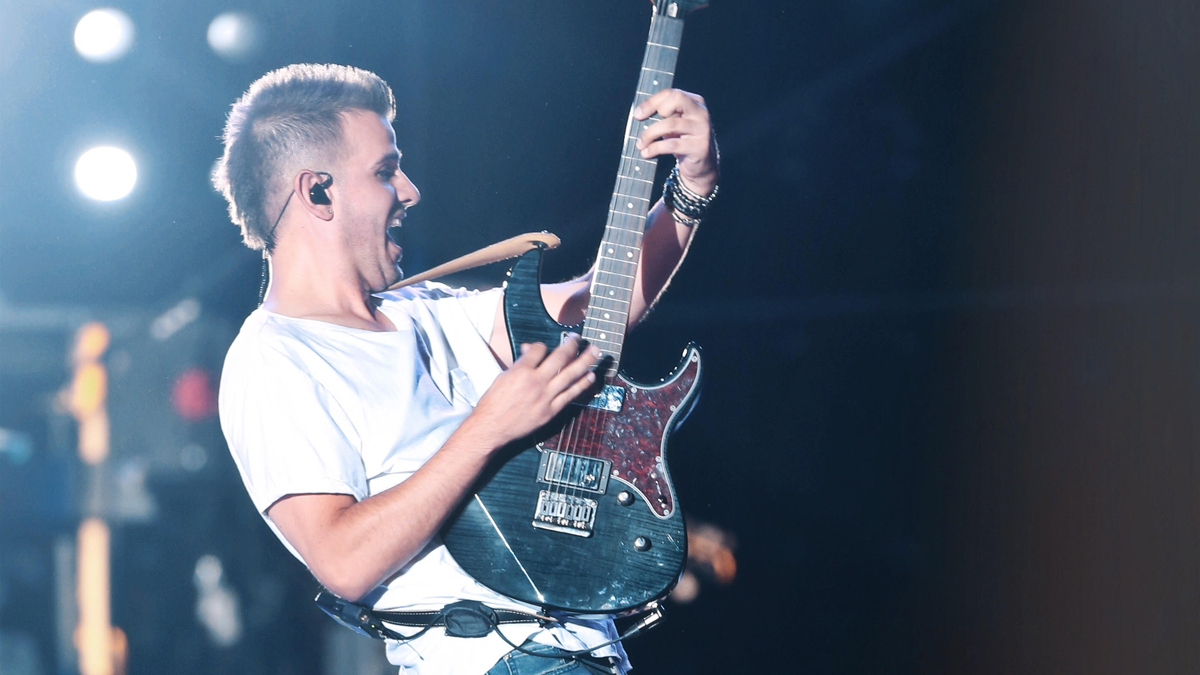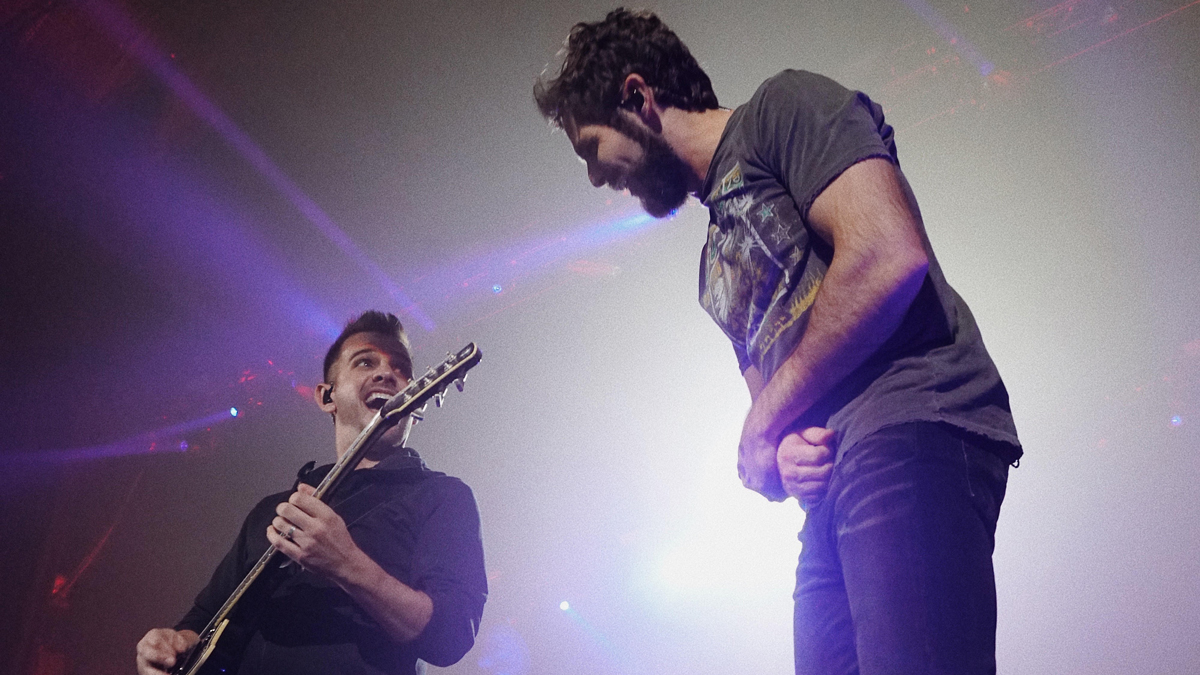Thomas Rhett guitarist Nathan Whitney: "When the call came, I was informed the tour was starting nine days later"
Guitar player for country megastar on his custom Yamahas, why he went digital, and how to land and keep the biggest session gigs

Touring the world as lead guitarist for Thomas Rhett requires laser focus, precise chops, and the ability to play well with others, both on stage and off.
Every hour of performance is counterbalanced by hours more living in close quarters with bandmates, sleeping in a bunk, and often watching endless stretches of highways speed by. The road is not for everyone, and it’s certainly not for novices.
By the time Nathan Whitney joined Rhett’s band - which comprises Chris Kimmerer (drums), Josh Reedy (guitar/keyboards), Travis Vance (bass), and Frank Houston (saxophone/keyboards) - the Toronto-based guitarist was as ready as one can be for such a life-altering experience. He had put in far more than the proverbial '10,000 hours' as a studio and touring musician, and was well versed in every aspect of the music industry.
Every job, every gig, helped prepare me for the opportunity I was presented with
“Every job, every gig, helped prepare me for the opportunity I was presented with,” he says.
Whitney began playing in bands as a teenager, and studied guitar through private lessons and as a college student. At university he began playing in jazz ensembles, which he says taught him to be “open to new information, analyse, and assimilate new concepts and ideas.”
From there, his resume grew exponentially: cruise ships, a punk band, numerous cover bands, an alternative indie band, and original Canadian country artists. Those tours included festival dates, where he gleaned two critical lessons: “I learned what it takes to entertain a larger crowd, and that having backup plans, both personally and gear-wise, is essential to ensuring a stress-free gig.”
When the call came to audition for Rhett in February 2017, he brought almost 20 years of experience to the table. “I'm thankful that I did have all these experiences,” he says, “as otherwise I'm not sure I would have had the confidence to succeed in the audition, rehearsals, and performances.”
Get the MusicRadar Newsletter
Want all the hottest music and gear news, reviews, deals, features and more, direct to your inbox? Sign up here.
Whitney was preparing for the next round of tour dates when MusicRadar caught up with him. He gave us insight about why every gig, no matter its size, is important to a musician’s upward climb, and what it takes to bring Thomas Rhett’s gold and platinum-selling songs to life every night.
What was key to being ready for your first night onstage with Thomas Rhett?
"When I first started playing guitar, an older musician mentor told me that if there is a job or gig you want, you have to work towards that gig and be ready when the call comes. I didn't take that to heart when I was younger, but as I progressed in my career, I knew there are a few artists that I would love to play for, Thomas being one of them.
"While I didn't invest a huge amount of time really digging into the songs when they came out, I did spend time making myself familiar with them by listening casually, as a fan and music lover, and also wrote charts out for each album. These charts sat on the shelf for years. But they were there.
When the call came, I was informed that the tour was starting nine days later
"When the call came, I was informed that the tour was starting nine days later. While I was nervous and excited - as anyone would be after getting this call - I simply walked over to my shelf, pulled out the charts that were already done, and began the process of digging into the details of the guitar parts. That call came at 10:30 on a Monday night, when I was in Toronto, and the next morning I was in Nashville, rehearsing with the band.
"We rehearsed six songs of the 17-song set in the first couple of hours. If I’d had to start from scratch, charting the songs that night after the call, I don't know if I would have been able to pull that off.
"In addition to my charts, the bandleader sent me 'board tapes of the live show, with the guitar part isolated to the right, the rest of the mix to the left. This was essential, as I was able to learn and duplicate the previous guitar player’s parts. Modern country records contain multiple guitar parts, so playing the correct part ensured the rest of the band heard what they were used to hearing, and the front-of-house audio engineer didn't have to adjust his mix too drastically to my way of playing."

Your job is to play the songs the way they were originally recorded and the way fans know them. Does that allow for adding a bit of yourself into the guitar parts?
"The most important thing to remember in any sideman job is that we are employees. Our names are not on the marquee. We didn't write the songs the people are there to hear. And as employees, we have to do what the job requires. For the Thomas Rhett gig - and, I would venture, a majority of high-level gigs in the country, pop, and rock worlds - the audience is there to hear the songs as they were performed on the record, or maybe with an arrangement twist. No-one came to hear me play guitar specifically. They came for Thomas and his songs. So, in that capacity, I play the parts as close to the record as possible.
"While it might be fun to put my own slant or twist on the parts, it does me no favours in retaining the gig if I do that without permission. That being said, in rehearsals the songs often do get rearranged, which makes them fresh and new in interesting ways every year. This keeps us all interested and pushes us as musicians.
"During this last year of touring, we also got little solo spots where we could play like we wanted and had no restrictions. It was fun to throw a little two-handed tapping into a country show!"
What gear are you using on the road?
"The job with Thomas requires a huge variety of tones. I'm currently endorsed by Yamaha Guitars. I grew up playing a used Yamaha Pacifica that I bought for $100 at the local music store. I had always loved the Strat-style body shape, and the neck shape just felt natural to my hands. I played that guitar throughout high school, college, and many of my early gigs.
When the opportunity to work with Yamaha came along, I jumped at the chance. It felt like coming home
"When the opportunity to work with Yamaha came along, I jumped at the chance. It felt like coming home. I use a Yamaha Pacifica PAC611VFMX in Translucent Black and a Pacifica PAC611HFM in Translucent Black. The HFM is tuned half-step down from standard.
"For songs that require mahogany and dual-humbucker tones, I use a Yamaha Revstar 720B in a Vintage Japanese Denim colour, a Burnt Charcoal Revstar RS620, and a Maya Gold Revstar RS420 that is set up with higher action for slide.
"I've also been a huge fan of Telecasters and have more than a few at home. I especially loved the Squier Classic Vibe Telecaster. That was a guitar I could beat up and it would still play great. Right now, I play a Fender American Special Telecaster in the show that Fender was kind enough to provide artist pricing to me on.
"In addition to my electric guitars, I play a Yamaha AC1M acoustic guitar for a few songs. I also play lap steel on a couple of songs in the set. I use a Recording King lap steel for these songs, tuned DADGAD.
"I've come to realise that 80 to 90 percent of electric guitar tone is in the pickups. If you have a well-built guitar, no matter what the price range, installing pickups that you like is essential to maximising the guitar’s potential.
"I started working with Mike ('Smitty') and Sue Smyth at MJS Custom Pickups about four years ago. While they ship all over the world, they're actually local to my home in Toronto. I've spent many hours at their shop, discussing my tonal needs, and Smitty has been able to realise these tones. The first time I played MJS pickups in my guitars, I thought, 'Wow, this is the tone I've been hearing on records but could never replicate.'
"In all my Revstars I have the MJS Split Single in the neck position and the MJS Humbucker IV in the bridge position. The Split Single is an amazing Alnico 5 magnet, split-coil design that fits a humbucker routing, but provides the tone of a single coil and is completely hum-free. The Humbucker IV is an Alnico 5 magnet with a 12k output impedance that is perfect for high-gain, hard-rock or metal tones.
"In my PAC611HFM, in the neck I have the MJS Big Single Retro, a P-90 style pickup that fits a Humbucker routing, and an MJS humbucker III with Alnico 5 that give me a perfect crunch in the bridge.
"In the PAC612VFMX, we actually changed the configuration to a single, single, hum. The two single coils are from the MJS Progressive Strat set. The neck is Alnico 5, rated at 7.0k ohms, the middle is RWRP Alnico 5 at 7.6k ohms, and the bridge humbucker is an MJS Hum III, Alnico 2, 11.6k ohms, with 12 individual pole pieces. Most humbuckers use a 500k volume pot, which causes the single-coil pickups to sound dull. The 12 individual pole pieces allowed us to use a 250k volume pot, which matches the single-coil pickups. In my Telecaster, I have the MJS Vintage Tele-style pickups in the neck and bridge.
"We use Shure wireless to get the signal from my guitar to my amp. And by amp, I mean digital amp. On the road we use Kemper Profilers. Using the Kemper provided me with the opportunity to load a bunch of profiles from some amazing commercial profile makers. Right now, I use the M Britt 3rd Power and Dumble profiles, Top Jimi Matchless profiles, and some Tone Junkie AC30 profiles.
"I'm exploring and testing out the Line 6 Helix. I've been creating IRs of the speaker section of some of my Kemper profiles, importing those into the Helix, and recreating my Kemper tones on the Helix. I know no matter which digital amp I choose to use on our upcoming tour, I'll have all the tones covered.
I can play a rhythm guitar part as I walk out onto the catwalk and have the patch change to my lead sound as I hit the end of the ramp for my guitar solo
"I love effect pedals, and at home I have an extensive pedalboard with pedals from MXR, Dunlop, Barber Electronics, JHS, XAct Tone, Electro-Harmonix and Line 6, but I don’t actually use a pedalboard or a controller for the Thomas Rhett gig. The great thing about the digital amplifiers is that they can receive patch changes via MIDI that are sent to us from our track computer from Ableton. This allows us to focus on playing and entertaining and leave the tap dancing between patches and tones up to the computer that is locked into our video content.
"The other great thing is I can play a rhythm guitar part as I walk out onto the catwalk and have the patch change to my lead sound as I hit the end of the ramp for my guitar solo. When the solo is done, it automatically changes back to my rhythm sound. No running halfway across a stadium stage just to turn off a lead boost!
"For picks, I've always been a fan of Dunlop. In my more shreddy days, I used the red Dunlop Jazz III picks. With Thomas, I use the heavy-gauge Dunlop Celluloid picks in a white celluloid colour. I also use the Dunlop Ultex picks for some tonal variation. I'm used to the heaviness of the thicker Jazz III picks and have had to rebuild my playing style slightly in order to use the lighter picks.
"We use Curt Mangan nickel-wound strings on the road. Right now, I use 0.010-0.046 on all my guitars, but I'm going to go to a 0.009-0.042 gauge on the Tele to facilitate my chicken picking a little easier, and a slightly heavier 0.011-0.052 on the Pacifica that is tuned down half a step, so that the strings don't feel too loose."

How do you keep your sound consistent?
"Using the digital amplifier has been my saving grace. I always struggled with inconsistent amplifiers and the speaker being affected by temperature and humidity. If you're traveling and using provided backline, you may request a certain version of an amplifier, but either not receive that amp or deal with a different version.
"I learned early on that if I wanted to have a Fender or Vox, I had to be very specific about which models and which speakers they had. While someone might say this is being too particular, the thing we strive to do is present the music in the highest standard possible, and that includes the tone. If a local backline company doesn't have a specific amp I requested in their inventory, I can still do the gig.
Enjoying the gig every night is essential. What you feel, how you look as you present the music - the audience picks up on that
"In addition to the amp itself, microphone type and placement could vary night to night. It's amazing what a one-inch difference in mic position can make to the tone coming out of front-of-house. Once again, the integrity of the music must be placed at the highest priority.
"While digital amplifiers have their own issues, being able to travel across North America and Europe with our 'amps' in a small road case has ensured the guitar sound going to front of house every night is the same, no matter the location or size of venue."
When you play for 70,000 people, how do you connect with the audience?
"Enjoying the gig every night is essential. What you feel, how you look as you present the music - the audience picks up on that. When we have video screens and cameras, that means playing up to the camera like you would for someone in the front row. It also means using your body language and facial expressions in a more direct way. In smaller venues it's easy enough to go over and rock out for a section of the audience. In larger venues, you have to use your face, your smile, whatever it is, to communicate to the camera and the audience.
"I've also found it a good practice to walk to the top of some of these arenas and stadiums before the show, to the farthest seat possible, and get the audience perspective. It helps me remember why I am there: to entertain. When I'm playing the show, I look up and out at those places and I point and smile at them. There is something magical about that act for me personally, silently telling them, 'I'm here for you tonight,' and I hope they feel that."

Do you have words of wisdom for musicians who aspire to, or have just landed, their 'big gig' - how to persevere during lean times and handle the pressure once they get there?
"If you're aspiring to do music as a career, no matter what stage you're in, be smart about your business. At the end of the day, you're a salesman, and the product you're selling is you! Watch your dollars and cents. Whether it's the money from the tip jar or from your salaried gig, you have to be prepared to handle that side of your business to ensure longterm success.
"On the music side of things, approach your job like a student. Whether you're playing stadiums across the world or the bar down the street, be open to learning everything from anybody. Whether it be a new way to approach a song, a new piece of gear you have no experience with, a new way to play a lick or wrap a cable, being open to new ways of doing things and taking the best of what you have learned can only make you better.
"Ultimately, never forget you're in the entertainment industry. Make music fun for yourself, for the musicians you work with, and most importantly, the people you're playing for! Be kind in your interactions, be thoughtful with your words, and try to leave this planet a better place for having you in it."
“They didn’t like Prince’s bikini underwear”: Prince’s support sets for the The Rolling Stones in 1981 are remembered as disastrous, but guitarist Dez Dickerson says that the the crowd reaction wasn’t as bad as people think
“We are so unencumbered and unbothered by these externally imposed rules or other people’s ideas for what music should be”: Blood Incantation on the making of Absolute Elsewhere and how “Data from Star Trek” saved the album – and the studio









